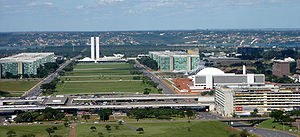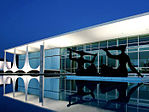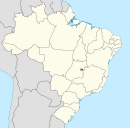Brasília
Brasília | |
|---|---|
| Região Administrativa de Brasília Administrative Region of Brasilia | |
| Nickname(s): Capital Federal, BSB, Capital da Esperança | |
| Motto(s): | |
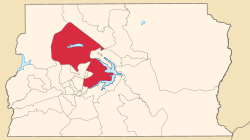 Location of Brasília in the Federal District | |
| Country | |
| Region | Central-West |
| State | |
| Founded | April 21, 1960 |
| Area | |
• Total | 5,802 km2 (2,240.164 sq mi) |
| Elevation | 1,172 m (3,845 ft) |
| Population (2011)(est.)[1] | |
• Total | 2,556,149 (4th) |
| • Density | 480.827/km2 (1,245.338/sq mi) |
| population of the Federal District | |
| Demonym | Brasiliense |
| GDP | |
| • Year | 2006 estimate |
| • Total | R$ 161,630,000,000 (8th) |
| • Per capita | R$ 61,915 (1st) |
| HDI | |
| • Year | 2014 |
| • Category | 0.911 (1st) |
| Time zone | UTC−3 (BRT) |
| • Summer (DST) | UTC−2 (BRST) |
| Postal code | 70000-000 |
| Area code | +55 61 |
| Website | Brasília, DF |
| Official name | Brasilia |
| Type | Cultural |
| Criteria | i, iv |
| Designated | 1987 (11th session) |
| Reference no. | 445 |
| Region | Latin America and the Caribbean |
Brasília (Portuguese pronunciation: [bɾaˈziljɐ]) is the federal capital of Brazil and seat of government of the Federal District. The city is located atop the Brazilian highlands in the country's center-western region. It was founded on April 21, 1960, to serve as the new national capital. Brasília and its metro (encompassing the whole of the Federal District) had a population of 2,556,149 in 2011, making it the 4th most populous city in Brazil.[2] Among major Latin American cities, Brasília has the highest GDP per capita at R$61,915 (US$36,175).[3][4]
Brasília was planned and developed by Lúcio Costa and Oscar Niemeyer in 1956 in order to move the capital from Rio de Janeiro to a more central location. The landscape architect was Roberto Burle Marx. The city's design divides it into numbered blocks as well as sectors for specified activities, such as the Hotel Sector, the Banking Sector and the Embassy Sector. Brasília was chosen as a UNESCO World Heritage Site due to its modernist architecture and uniquely artistic urban planning.[5]
The centers of all three branches of the federal government of Brazil are in Brasília, including the Congress, President, and Supreme Court. The city also hosts 124 foreign embassies.[6] Brasília International Airport connects the capital to all major Brazilian cities and many international destinations, and is the third busiest airport in Brazil.
The city has a unique status in Brazil, as it is an administrative division rather than a legal municipality like other cities in Brazil. The name 'Brasília' is commonly used as a synonym for the Federal District through synecdoche; However, the Federal District is composed of 31 administrative regions, only one of which is Brasília proper, with a population of 209,926 in a 2011 survey; Demographic publications generally do not make this distinction and list the population of Brasília as synonymous with the population of the Federal District, considering the whole of it as its metropolitan area. The city was one of the main host cities of the 2014 FIFA World Cup. Additionally, Brasília hosted the 2013 FIFA Confederations Cup.
History

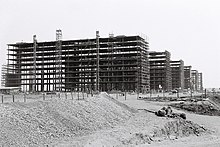
Background
From 1763 until 1960, Rio de Janeiro was the capital of Brazil. At this time, resources tended to be centered in Brazil's southeast region near Rio de Janeiro. Brasília's geographically central location fostered a more regionally neutral federal capital. An article of the country's first republican constitution dating back to 1891 stated that the capital should be moved from Rio de Janeiro to a place close to the center of the country.
The plan was originally conceived in 1827 by José Bonifácio, an advisor to Emperor Pedro I. He presented a plan to the General Assembly of Brazil for a new city called Brasília, with the idea of moving the capital westward from the heavily populated southeastern corridor. The bill was not enacted because Pedro I dissolved the Assembly.
According to legend, Italian saint Don Bosco in 1883 had a dream in which he described a futuristic city that roughly fitted Brasília's location.[7] In Brasília today, many references of Bosco, who founded the Salesian order, are found throughout the city and one church parish in the city bears his name.[8]
Construction
Juscelino Kubitschek, President of Brazil from 1956 to 1961, ordered the construction of Brasília, fulfilling the promise of the Constitution and his own political campaign promise. Building Brasília was part of Juscelino's "fifty years of prosperity in five" plan. Lúcio Costa won a contest and was the main urban planner in 1957, with 5550 people competing. Oscar Niemeyer, a close friend, was the chief architect of most public buildings and Roberto Burle Marx was the landscape designer. Brasília was built in 41 months, from 1956 to April 21, 1960, when it was officially inaugurated.
Until the 1980s, the governor of the Federal District was appointed by the Federal Government, and the laws of Brasília were issued by the Brazilian Federal Senate. With the Constitution of 1988 Brasília gained the right to elect its Governor, and a District Assembly (Câmara Legislativa) was elected to exercise legislative power.[9] The Federal District does not have a Judicial Power of its own. The Judicial Power which serves the Federal District also serves federal territories. Currently, Brazil does not have any territories, therefore, for now the courts serve only cases from the Federal District.
Geography

Paranoá Lake
Paranoá Lake is a large artificial lake built to increase the amount of water available and the humidity of the region. It has the second largest marina in Brazil, and hosts wakeboarders and windsurfers. Diving can also be practiced and one of the main attractions is Vila Amaury, an old village that is submerged in the lake. This is where the first construction workers of Brasília used to live.
Climate
Brasília has a tropical savanna climate (Aw) according to the Köppen system, with two distinct seasons: the rainy season, from October to April, and a dry season, from May to September.[10] The average temperature is 20.6 °C (69.1 °F). September, at the end of the dry season, has the highest average maximum temperature, 28.3 °C (82.9 °F), has major and minor lower maximum average temperature, of 25.1 °C (77.2 °F) and 12.9 °C (55.2 °F), respectively.[11][12] Average temperatures from September through March are a consistent 22 °C (72 °F).[13] With 247.4 mm (9.7 in), January is the month with the highest rainfall of the year, while June is the lowest, with only 8.7 mm (0.3 in).[14]
According to Brazilian National Institute of Meteorology (INMET), the record low temperature was 1.6 °C (34.9 °F) in July 18, 1975, and the record high was 35.8 °C (96.4 °F) in October 28, 2008. The highest accumulated rainfall in 24 hours was 132.8 mm (5.2 in) on November 15, 1963.[15] Template:Brasília weatherbox
Demographics

According to the 2010 IBGE Census, there were 2,469,489 people residing in Brasília and its metropolitan area,[16] of which 1,239,882 were Pardo (multiracial) (48.2%), 1,084,418, White (42.2%), 198,072, Black (7.7%), 41,522, Asian (1.6%), and 6,128 Amerindian (0.2%).[17]
In 2010, Brasília was ranked the fourth most-populous city in Brazil after São Paulo, Rio de Janeiro, and Salvador.[18] In 2010, the city had 474,871 opposite-sex couples and 1,241 same-sex couples. The population of Brasília was 52.2% female and 47.8% male.[17]
In the 1960 census there were almost 140 thousand residents in the new Federal District. By 1970 this figure had grown to 537 thousand. By 2000 the population of the Federal District had surpassed 2 million. The city of Brasília proper was planned for only about 500 thousand inhabitants, but its metropolitan area has grown past this figure.[19]
From the beginning, the growth of Brasília was greater than original estimates. According to the original plans, Brasília would be a city for government authorities and staff. However, during the construction period, Brazilians from all over the country migrated to Brasília, seeking public and private jobs.[20]
At the close of the 20th century, Brasília held the distinction of being the largest city in the world which had not existed at the beginning of the century.[21] Brasília has one of the highest population growth rates in Brazil, with annual growth of 2.82%, mostly due to internal migration.
Brasília's inhabitants include a foreign population of mostly embassy workers as well as large numbers of Brazilian internal migrants. Today, the city has important communities of immigrants and refugees. The city's Human Development Index was 0.936 in 2000 (developed nation level), and the city's illiteracy rate was around 4.35%.
Education

The Portuguese language is the official national language and the primary language taught in schools. English and Spanish are also part of the official curriculum. The city has six international schools: American School of Brasília, Brasília International School (BIS), Escola das Nações, Swiss International School (SIS), Lycée français François-Mitterrand (LfFM) and Maple Bear Canadian School.[22] Brasília has two universities, three university centers, and many private colleges.
The main tertiary educational institutions are: Universidade de Brasília – University of Brasília (UnB) (public); Universidade Católica de Brasília – Catholic University of Brasília (UCB); Centro Universitário de Brasília (UniCEUB); Centro Universitário Euroamaricano (Unieuro); Centro Universitário do Distrito Federal (UDF); Universidade Paulista (UNIP); and Instituto de Educação Superior de Brasília (IESB).
Religion


The Cathedral of Brasília in the capital of the Federative Republic of Brazil, is an expression of the architect Oscar Niemeyer. This concrete-framed hyperboloid structure, seems with its glass roof reaching up, open, to the heavens. On 31 May 1970, the Cathedral’s structure was finished, and only the 70 m (229.66 ft) diameter of the circular area were visible. Niemeyer's project of Cathedral of Brasília is based in the hyperboloid of revolution which sections are asymmetric. The hyperboloid structure itself is a result of 16 identical assembled concrete columns. These columns, having hyperbolic section and weighing 90 t, represent two hands moving upwards to heaven. The Cathedral was dedicated on 31 May 1970.
| Religion | Percentage | Number |
|---|---|---|
| Catholic | 56.62% | 1,455,134 |
| Protestant | 26.88% | 690,982 |
| No religion | 9.20% | 236,528 |
| Spiritist | 3.50% | 89,836 |
| Jewish | 0.04% | 1103 |
| Muslim | 0.04% | 972 |
Politics

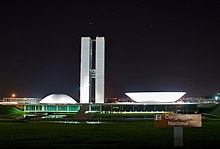
Brazil's bicameral National Congress consists of the Senate (the upper house) and the Chamber of Deputies of Brazil (the lower house). Since the 1960s, the National Congress has been located in Brasília.
As with most official buildings throughout the city, it was designed by Oscar Niemeyer in the style of modern Brazilian architecture. The hemisphere to the left is the seat of the Senate and the hemisphere to the right is the seat of the Chamber of Deputies. The Congress also occupies various other surrounding buildings, some connected by tunnels.
The National Congress building is located in the middle of the Eixo Monumental, the city's main avenue. In front lies a large lawn and reflecting pool. The building faces the Praça dos Três Poderes where the Palácio do Planalto and the Supremo Tribunal Federal are located.
International relations
- Twin towns and sister cities
 Abuja, Nigeria[24]
Abuja, Nigeria[24] Asunción, Paraguay[24]
Asunción, Paraguay[24] Brussels, Belgium[24]
Brussels, Belgium[24] Buenos Aires, Argentina (since 2002)[24]
Buenos Aires, Argentina (since 2002)[24] Gaza City, Palestine[24]
Gaza City, Palestine[24] Havana, Cuba[24]
Havana, Cuba[24] Khartoum, Sudan[24]
Khartoum, Sudan[24] Lisbon, Portugal[25]
Lisbon, Portugal[25] Luxor, Egypt[24]
Luxor, Egypt[24] Montevideo, Uruguay[24]
Montevideo, Uruguay[24] Pretoria, South Africa[24]
Pretoria, South Africa[24] Santiago, Chile[24]
Santiago, Chile[24] Tehran, Iran[24]
Tehran, Iran[24] Vienna, Austria[24]
Vienna, Austria[24] Washington D.C., United States (since 2013)[26]
Washington D.C., United States (since 2013)[26] Xi'an, China (since 1997)[24]
Xi'an, China (since 1997)[24]
Of these, Abuja, Canberra, and Washington D.C. were likewise cities planned specifically to be their respective countries' seats of government.
Cityscape
At the northwestern end of the Monumental Axis are federal district and municipal buildings, while at the southeastern end, near the middle shore of Lake Paranoá, stand the executive, judicial, and legislative buildings around the Square of Three Powers, the conceptual heart of the city.[27]

These and other major structures were designed by Brazilian architect Oscar Niemeyer. In the Square of Three Powers, he created as a focal point the dramatic Congressional Palace, which is composed of five parts: twin administrative towers flanked by a large, white concrete dome (the meeting place of the Senate) and by an equally massive concrete bowl (the Chamber of Deputies), which is joined to the dome by an underlying, flat-roofed building.[28]
A series of low-lying annexes (largely hidden) flank both ends. Also in the square are the glass-faced Planalto Palace housing the presidential offices, and the Palace of the Supreme Court. Farther east, on a triangle of land jutting into the lake, is the Palace of the Dawn (Palácio da Alvorada; the presidential residence). Between the federal and civic buildings on the Monumental Axis is the city's cathedral, considered by many to be Niemeyer's finest achievement (see photographs of the interior). The parabolically shaped structure is characterized by its 16 gracefully curving supports, which join in a circle 115 feet (35 meters) above the floor of the nave; stretched between the supports are translucent walls of tinted glass. The nave is entered via a subterranean passage rather than conventional doorways. Other notable buildings are Buriti Palace, Itamaraty Palace, the National Theater, and several foreign embassies that creatively embody features of their national architecture. The Brazilian landscape architect Roberto Burle Marx designed landmark modernist gardens for some of the principal buildings.[29]
Both low-cost and luxury housing were built by the government in the Brasília. The residential zones of the inner city are arranged into superquadras ("superblocks"): groups of apartment buildings along with a prescribed number and type of schools, retail stores, and open spaces. At the northern end of Lake Paranoá, separated from the inner city, is a peninsula with many fashionable homes, and a similar city exists on the southern lakeshore. Originally the city planners envisioned extensive public areas along the shores of the artificial lake, but during early development private clubs, hotels, and upscale residences and restaurants gained footholds around the water. Set well apart from the city are satellite cities, including Gama, Ceilândia, Taguatinga, Núcleo Bandeirante, Sobradinho, and Planaltina. These cities, with the exception of Gama and Sobradinho were not planned.[30]
Monumental civic scale
The city has been both acclaimed and criticized for its use of modernist architecture on a grand scale and for its somewhat utopian city plan.[31]
After a visit to Brasília, the French writer Simone de Beauvoir complained that all of its superquadras exuded "the same air of elegant monotony," and other observers have equated the city's large open lawns, plazas, and fields to wastelands. As the city has matured, some of these have gained adornments, and many have been improved by landscaping, giving some observers a sense of "humanized" spaciousness. Although not fully accomplished, the "Brasília utopia" has produced a city of relatively high quality of life, in which the citizens live in forested areas with sporting and leisure structure (the superquadras) flanked by small commercial areas, bookstores and cafes; the city is famous for its cuisine and efficiency of transit.[31]
Even these positive features have sparked controversy, expressed in the nickname "ilha da fantasia" ("fantasy island"), indicating the sharp contrast between the city and surrounding regions, marked by poverty and disorganization in the cities of the states of Goiás and Minas Gerais, around Brasília.[31]
Critics of Brasília's grand scale have characterized it as a modernist platonic fantasy about the future:
Nothing dates faster than people's fantasies about the future. This is what you get when perfectly decent, intelligent, and talented men start thinking in terms of space rather than place; and single rather than multiple meanings. It's what you get when you design for political aspirations rather than real human needs. You get miles of jerry-built platonic nowhere infested with Volkswagens. This, one may fervently hope, is the last experiment of its kind. The utopian buck stops here.
— Robert Hughes, The Shock of the New, Episode 4: "Trouble in Utopia", (1980)
Economy

The major roles of construction and of services (government, communications, banking and finance, food production, entertainment, and legal services) in Brasília's economy reflect the city's status as a governmental rather than an industrial center. Industries connected with construction, food processing, and furnishings are important, as are those associated with publishing, printing, and computer software. GDP is divided in Public Administration 54.8%, Services 28.7%, Industry 10.2%, Commerce 6.1%, Agribusiness 0.2%.[32]
Besides being the political center, Brasília is an important economic center. Brasília has the highest city gross domestic product (GDP) of 99.5 billion reais representing 3.76% of the total Brazilian GDP. The main economic activity of the federal capital results from its administrative function. Its industrial planning is studied carefully by the Government of the Federal District. Being a city registered by UNESCO, the government in Brasília has opted to encourage the development of non-polluting industries such as software, film, video, and gemology among others, with emphasis on environmental preservation and maintaining ecological balance, preserving the city property.
According to Mercer's city rankings of cost of living for expatriate employees, Brasília ranks 45th among the most expensive cities in the world in 2012, up from the 70th position in 2010, ranking behind São Paulo (12th) and Rio de Janeiro (13th).
Services

(91% of local GDP, according to the IBGE):
- Government – the public sector is by far the largest employer, accounting for around 40% of the city jobs. Government jobs include all levels, from the federal police to diplomacy, from the transportation bureau to the armed forces;
- Communications – the telephony used to be a state monopoly, and Brasília held the HQ of Telebrás, the central state company; one of the enterprises that resulted from the privatization of the system in the 90's, Brasil Telecom, keeps it HQ in the city; the official Postal Service (Correios) HQ is located in the city as well; as it is the main place of Federal Government news, it is also notable the activities of TV stations, including the main offices of four public networks (TV Brasil/Agência Brasil, TV Câmara, TV Senado and TV Justiça), the regional offices of four major private television networks (Rede Globo, SBT, Rede Bandeirantes and Rede Record) and a main affiliate of RedeTV!;
- Banking and finance – headquarters of the Banco do Brasil and the Caixa Econômica Federal, both controlled by the Federal Government, and the Banco de Brasília, controlled by the city local government; it is also the site of the headquarters of the Central Bank, the main government regulatory agency of the financial sector;
- Entertainment – the shopping malls Conjunto Nacional, ParkShopping, Pátio Brasil Shopping, Brasília Shopping, Boulevard Shopping, Taguatinga Shopping, Terraço Shopping, Gilberto Salomão and Iguatemi Brasília.
- Information technology (Politec, Poliedro, CTIS, among others), and legal services.
Industries

In the city include: Construction (Paulo Octavio, Via Construções, and Irmãos Gravia among others); Food processing (Perdigão, Sadia); Furniture Making; Recycling (Novo Rio, Rexam, Latasa and others); Pharmaceuticals (União Química); Graphic industries. The main agricultural products produced in the city are coffee, guavas, strawberries, oranges, lemons, papayas, soy beans, and mangoes. It has over 110,000 cows and it exports wood products worldwide.
The Federal District, where Brasília is located, has a GDP of R$133,4 billion (about US$64.1 billion), about the same as Belarus according to The Economist. Its share of the total Brazilian GDP is about 3.8%.[33] The Federal District has the largest GDP per capita income of Brazil US$25,062, slightly higher than Belarus.[33]
The city's planned design included specific areas for almost everything, including accommodation, Hotels Sectors North and South. New hotel facilities are being developed elsewhere, such as the hotels and tourism Sector North, located on the shores of Lake Paranoá. Brasília has a range of tourist accommodation from inns, pensions and hostels to larger international chain hotels. The city's restaurants cater to a wide range of foods from local and regional Brazilian dishes to international cuisine.
Culture

As a venue for political events, music performances and movie festivals, Brasília is a cosmopolitan city, with around 124 embassies, a wide range of restaurants and complete infrastructure ready to host any kind of event. Not surprisingly, the city stands out as an important business tourism destination, which is an important part of the local economy, with dozens of hotels spread around the federal capital. Traditional parties take place throughout the year.
In June, large festivals known as "festas juninas" are held celebrating Catholic saints such as Saint Anthony of Padua, Saint John the Baptist, and Saint Peter. On September 7, the traditional Independence Day parade is held on the Ministries Esplanade. Throughout the year, local, national, and international events are held throughout the city. Christmas is widely celebrated, and New Year's Eve usually hosts major events.[34]
The city also hosts a varied assortment of art works from artists like Bruno Giorgi, Alfredo Ceschiatti, Athos Bulcão, Marianne Peretti, Alfredo Volpi, Di Cavalcanti, Dyllan Taxman, Victor Brecheret and Burle Marx, whose works have been integrated into the city's architecture, making it a unique landscape. The cuisine in the city is very diverse. Many of the best restaurants in the city can be found in the Asa Sul district.[35]
The city is also the birthplace of Brazilian rock and place of origin of many bands like: Legião Urbana, Capital Inicial, Aborto Elétrico, Plebe Rude and Raimundos. Currently Brasília has the Rock Basement Festival who attempts to bring new bands to the national scene. The festival is held in the parking Brasilia National Stadium Mané Garrincha.
Brasília has also been the focus of modern-day literature. Published in 2008, The World In Grey: Dom Bosco's Prophecy, by author Ryan J. Lucero, tells an apocalypticle story based on the famous prophecy from the late 19th century by the Italian saint Don Bosco.[36] According to Don Bosco's prophecy:[37] "Between parallels 15 and 20, around a lake which shall be formed; A great civilization will thrive, and that will be the Promised Land." Brasília lies between the parallels 15° S and 20° S, where an artificial lake (Paranoá Lake) was formed. Don Bosco is Brasília's patron saint.
American Flagg!, the First Comics comic book series created by Howard Chaykin, portrays Brasília as a cosmopolitan world capital of culture and exotic romance. In the series, it is a top vacation and party destination. The 2015 Rede Globo series Felizes para Sempre? was set in Brasília.[38]
Historic sites and museums
- Monumental Axis and Square of the Three Powers

At the end of the Eixo Monumental ("Monumental Axis") lies the Esplanada dos Ministérios ("Ministries Esplanade"), an open area in downtown Brasília. The rectangular lawn is surrounded by two eight-lane avenues where many government buildings, monuments and memorials are located. On Sundays and holidays, the Eixo Monumental is closed to cars so that locals may use it as a place to walk, bike, and have picnics under the trees.
Praça dos Três Poderes (Portuguese for Square of the Three Powers) is a plaza in Brasília. The name is derived from the encounter of the three federal branches around the plaza: the Executive, represented by the Palácio do Planalto (presidential office); the Legislative, represented by the National Congress (Congresso Nacional); and the Judicial branch, represented by the Supreme Federal Court (Supremo Tribunal Federal). It is a tourist attraction in Brasília, designed by Lúcio Costa and Oscar Niemeyer as a place where the three branches would meet harmoniously.
- Palaces
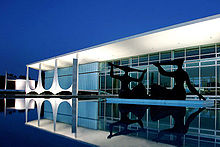

The Palácio da Alvorada is the official residence of the President of Brazil. The palace was designed, along with the rest of the city of Brasília, by Oscar Niemeyer and inaugurated in 1958. One of the first structures built in the republic's new capital city, the "Alvorada" lies on a peninsula at the margins of Lake Paranoá. The principles of simplicity and modernity, that in the past characterized the great works of architecture, motivated Niemeyer. The viewer has an impression of looking at a glass box, softly landed on the ground with the support of thin external columns. The building has an area of 7,000 m2 with three floors consisting of the basement, landing, and second floor. The auditorium, kitchen, laundry, medical center, and administration offices are at basement level. The rooms used by the presidency for official receptions are on the landing. The second floor has four suites, two apartments, and various private rooms which make up the residential part of the palace. The building also has a library, a heated Olympic-sized swimming pool, a music room, two dining rooms and various meeting rooms. A chapel and heliport are in adjacent buildings.
The Palácio do Planalto is the official workplace of the President of Brazil. It is located at the Praça dos Três Poderes in Brasília. As the seat of government, the term "O Planalto" is often used as a metonym for the executive branch of government. The main working office of the President of the Republic is in the Palácio do Planalto. The President and his or her family do not live in it, rather in the official residence, the Palácio da Alvorada. Besides the President, senior advisors also have offices in the "Planalto," including the Vice-President of Brazil and the Chief of Staff. The other Ministries are along the Esplanada dos Ministérios. The architect of the Palácio do Planalto was Oscar Niemeyer, creator of most of the important buildings in Brasília. The idea was to project an image of simplicity and modernity using fine lines and waves to compose the columns and exterior structures. The Palace is four stories high, and has an area of 36,000 m2. Four other adjacent buildings are also part of the complex.
Transportation
Airport


Brasília–Presidente Juscelino Kubitschek International Airport serves the metropolitan area with major domestic and international flights. It is the third busiest Brazilian airport based on passengers and aircraft movements.[39] Because of its strategic location it is a civil aviation hub for the rest of the country.
This makes for a large number of takeoffs and landings and it is not unusual for flights to be delayed in the holding pattern before landing. Following the airport's master plan, Infraero built a second runway, which was finished in 2006. In 2007, the airport handled 11,119,872 passengers.[39] The main building's third floor, with 12 thousand square meters, has a panoramic deck, a food court, shops, four movie theatres with total capacity of 500 people, and space for exhibitions. Brasília Airport has 136 vendor spaces. The airport is located about 11 km (6.8 mi) from the central area of Brasília, outside the metro system. The area outside the airport's main gate is lined with taxis as well as several bus line services which connect the airport to Brasília's central district. The parking lot accommodates 1,200 cars.[40] The airport is serviced by domestic and regional airlines (TAM, GOL, Azul, WebJET, Trip and Avianca), in addition to a number of international carriers. In 2012, Brasília's International Airport was won by the InfrAmerica consortium, formed by the Brazilian engineering company ENGEVIX and the Argentine Corporacion America holding company, with a 50% stake each.[41] During the 25-year concession, the airport may be expanded to up to 40 million passengers a year.[42]
In 2014, the airport received 15 new boarding bridges, totalling 28 in all. This was the main requirement made by the federal government, which transferred the operation of the terminal to the Inframerica Group after an auction. The group invested R$750 million in the project. In the same year, the number of parking spaces doubled, reaching three thousand. The airport's entrance have a new rooftop cover and a new access road. Furthermore, a VIP room was created on Terminal 1's third floor. The investments resulted an increase the capacity of Brasília's airport from approximately 15 million passengers per year to 21 million by 2014.[43] Brasília has direct flights to all states of Brazil and direct international flights to Atlanta, Buenos Aires, Lisbon, Miami, Panama City, and Paris.[44]
Road transport

Like most Brazilian cities, Brasilia has a good network of taxi companies. Taxis from the airport are available immediately outside the terminal, but at times there can be quite a queue of people. Although the airport is not far from the downtown area, taxi prices do seem to be higher than in other Brazilian cities. Booking in advance can be advantageous, particularly if time is limited, and local companies should be able to assist airport transfer or transport requirements.
The Juscelino Kubitschek bridge, also known as the 'President JK Bridge' or the 'JK Bridge', crosses Lake Paranoá in Brasília. It is named after Juscelino Kubitschek de Oliveira, former president of Brazil. It was designed by architect Alexandre Chan and structural engineer Mário Vila Verde. Chan won the Gustav Lindenthal Medal[45] for this project at the 2003 International Bridge Conference in Pittsburgh due to "...outstanding achievement demonstrating harmony with the environment, aesthetic merit and successful community participation".
It consists of three 60 m (200 ft) tall asymmetrical steel arches that crisscross diagonally. With a length of 1,200 m (0.75 miles), it was completed in 2002 at a cost of US$56.8 million. The bridge has a pedestrian walkway and is accessible to bicyclists and skaters.
Public transport
- Metro

Metrô de Brasília is Brasília's underground metro system. The subway system has 24 stations on two lines, the Orange and Green lines, distributed along a total network of 42 km (26 mi), covering some of the metropolitan area. Both lines begin at the Central Station and run parallel until the Águas Claras Station. The Brasília metro is not comprehensive, so buses may provide better access to the city centre.
The metro leaves the Rodoviária (bus station) and goes south, avoiding most of the political and tourist areas. The main purpose of the metro is to serve cities, such as Samambaia, Taguatinga and Ceilândia, as well as Guará and Águas Claras. The satellite cities served are more populated in total than the Plano Piloto itself (the census of 2000 indicated that Ceilândia had 344,039 inhabitants, Taguatinga had 243,575, whereas the Plano Piloto had approximately 400,000 inhabitants), and most residents of the satellite cities depend on public transportation.[46]
A high-speed railway was planned between Brasília and Goiânia, the capital of the state of Goias, although it will probably be turned into a regional service linking these capital cities and cities in between, like Anápolis and Alexânia.[47]
Buses
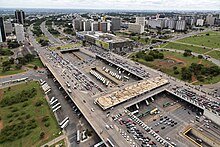
The main bus hub in Brasília is the Central Bus Station, located in the crossing of the Eixo Monumental and the Eixão, about 2 km (1.2 mi) from the Three Powers Plaza. The original plan was to have a bus station as near as possible to every corner of Brasília. Today, the bus station is the hub of urban buses only, some running within Brasília and others connecting Brasília to the satellite cities.
In the original city plan, the interstate buses should also stop at the Central Station. Because of the growth of Brasília (and corresponding growth in the bus fleet), today the interstate buses leave from the older interstate station (called Rodoferroviária), located at the western end of the Eixo Monumental. The Central Bus Station also contains a main metro station. A new bus station was opened in July 2010. It is on Saída Sul (South Exit) near Parkshopping Mall and with its metro station, and it's also an inter-state bus station, used only to leave the Federal District.
Sports
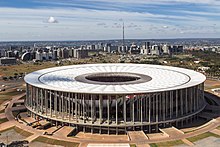
The three most well known teams of Brasília are: Brasiliense FC from Taguatinga (Commonly called Jacaré, the "Caiman"); SE Gama (Commonly called Verdão, the "Big Green"); and Brasília Futebol Clube (Commonly called Colorado, The Reds'). Both teams won the Série B of the Brazilian Football Championship once (Gama in 1998 and Brasiliense in 2004), but they failed to be successful in the Série A. As of 2014, Brasiliense will play the Série D, while Gama only plays the Metropolitan league and doesn't even participate in the Série D. The main stadiums are the Brasilia National Stadium Mané Garrincha (which was reinaugurated on May 18, 2013), the Serejão Stadium (home for Brasiliense) and the Bezerrão Stadium (home for Gama).
Brasília was one of the host cities of the 2014 FIFA World Cup and 2013 FIFA Confederations Cup, for which Brazil is the host nation. Brasília hosted the opening of the Confederations Cup and hosted 7 World Cup games.[48] Brasília will also host football tournaments during the 2016 Summer Olympics to be held in Rio de Janeiro.

Brasília is known as a departing point for the practice of unpowered air sports, sports that may be practiced with hang gliding or paragliding wings. Practitioners of such sports reveal that, because of the city's dry weather, the city offers strong thermal winds and great "cloud-streets", which is also the name for a manoeuvre quite appreciated by practitioners. In 2003, Brasília hosted the 14th Hang Gliding World Championship, one of the categories of free flying. In August 2005, the city hosted the 2nd stage of the Brazilian Hang Gliding Championship.
Brasília is the site of the Autódromo Internacional Nelson Piquet which hosted a non-championship round of the 1974 Formula One Grand Prix season.
The city is also home to Uniceub BRB, one of Brazil's best basketball clubs. Currently, NBB champion (2010, 2011 and 2012). The club hosts some of its games at the 16,000 all-seat Nilson Nelson Gymnasium.
See also
- Flag of the Federal District
- Coat of arms of the Federal District
- List of administrative regions in Federal District
- The Brazilian state capitals of Palmas, Goiânia, Belo Horizonte, Aracaju, Teresina and Boa Vista
- Australia's capital Canberra, also a purpose-built city
- India's capital New Delhi
- The capital of Burma, Naypyidaw
- The capital of Kazakhstan, Astana
- Malaysia's Putrajaya, the federal administrative center of the country, also a purpose-built city
- Pakistan's capital Islamabad, also a purpose-built in the 1960s
- The United States' capital Washington, D.C.
- The capital of Nigeria, Abuja
References
- ^ "Estimativa Populacional 2013" (PDF). Pesquisa Demográfica por Amostra de Domicílios 2011 (in Portuguese). Codeplan. 2012-11-09. Retrieved 2015-06-06.
- ^ IBGE: Brasília IBGE. Retrieved on 2014-09-07. Template:Pt icon.
- ^ http://www.urosario.edu.co/urosario_files/9d/9d96f884-d433-45a8-947b-4e9877596f63.pdf
- ^ Istrate, Emilia. "Global MetroMonitor | Brookings Institution". Brookings.edu. Retrieved 2014-02-25.
- ^ "World Heritage List". Unesco. Retrieved February 6, 2013.
- ^ "Lista do Corpo Diplomático e Organismos Internacionais". Cerimonial, Ministério das Relações Exteriores. Retrieved August 18, 2011.
- ^ "São João Bosco". Don Bosco Sanctuary website (in Portuguese). Retrieved 2013-03-08.
- ^ About Brasilia Brazil Template:En icon
- ^ History of Brasília Template:En icon
- ^ A cidade das duas estações (in Brazilian Portuguese).
- ^ Cite error: The named reference
AverageLowC_INMETwas invoked but never defined (see the help page). - ^ Cite error: The named reference
AverageHighC_INMETwas invoked but never defined (see the help page). - ^ Cite error: The named reference
DailyMeanC_INMETwas invoked but never defined (see the help page). - ^ Cite error: The named reference
Rainfall_INMETwas invoked but never defined (see the help page). - ^ Rodovia com 1,8 km e frio europeu; veja os 'extremos' de Brasília (in Brazilian Portuguese).
- ^ 2010 IGBE Census Template:Pt icon
- ^ a b 2010 IGBE Census Template:Pt icon
- ^ The largest Brazilian cities - 2010 IBGE Census } Template:Pt icon
- ^ "Population of Brasília". Geocities.com. January 17, 2007. Archived from the original on October 26, 2009. Retrieved April 17, 2010.
- ^ "Immigration to Brasília". Aboutbrasilia.com. Retrieved April 17, 2010.
- ^ Brasília in the World Template:En icon
- ^ International schools in Brasília Template:En icon
- ^ "Religion in Brasília by IBGE". Sidra.ibge.gov.br. Retrieved 11 October 2012.
- ^ a b c d e f g h i j k l m n o "Brasilia Global Partners". Internacional.df.gov.br. Archived from the original on 28 February 2014. Retrieved 2014-02-25.
{{cite web}}: Unknown parameter|deadurl=ignored (|url-status=suggested) (help) [dead link] - ^ "Lisboa - Geminações de Cidades e Vilas". Associação Nacional de Municípios Portugueses [National Association of Portuguese Municipalities] (in Portuguese). Retrieved 2013-08-23.
{{cite web}}: Unknown parameter|trans_title=ignored (|trans-title=suggested) (help) - ^ Martin Austermuhle (2012-03-15). "D.C., Welcome Your Newest Sister City: Brasília". Dcist.com. Retrieved 2013-03-18.
- ^ Brasília Template:En icon
- ^ Brasília, Brazil (UNESCO site) Template:En icon
- ^ Brasília Template:En icon
- ^ Brasília Template:En icon
- ^ a b c Brasília - Britannica Template:En icon
- ^ "GDP – Division – Federal District". Gdf.df.gov.br. Retrieved April 17, 2010.
- ^ a b "Comparing Brazilian states with countries". Economist.com. 2011-09-05. Retrieved 2014-02-25.
- ^ Brasília Template:En icon
- ^ "Culture in Brasília". Travelbite.co.uk. August 9, 2006. Retrieved April 17, 2010.
- ^ "Dom Bosco – Brasília". Infobrasilia.com.br. April 21, 1965. Retrieved April 17, 2010.
- ^ "Dom Bosco – Brasília". Flickr.com. March 24, 2009. Retrieved April 17, 2010.
- ^ Natália Castro (8 December 2014). "Maria Fernanda Cândido e Enrique Diaz gravam com Fernando Meirelles nova série da Globo, em Brasilia". O Globo. Revista da TV. Retrieved 22 December 2014.
- ^ a b Airport Statistics for 2007 http://www.infraero.gov.br/upload/arquivos/movi/mov.operac.1207.pdf
- ^ "Brasilia International Airport – facts". Aboutbrasilia.com. January 4, 2007. Retrieved April 17, 2010.
- ^ Brazilian Airport Privatization – Second Round Concessions Template:En icon
- ^ Brazil Opens First Expansion at a Privately Operated Airport Template:En icon
- ^ Inframerica Group will invest R$ 750 million in Brasilia’s Airport Template:En icon
- ^ International flights - Brasília International Airport Template:En icon
- ^ "Bridge Awards". Eswp.com. Retrieved May 5, 2009.
- ^ "Brasília Metro". Metro.df.gov.br. Retrieved 2014-02-25.
- ^ Fábio Amato Do G1, em Brasília (2012-06-28). "G1 - Estudo vai apontar viabilidade de trem entre Brasília, Anápolis e Goiânia - notícias em Distrito Federal". G1.globo.com. Retrieved 2013-03-12.
{{cite web}}: CS1 maint: numeric names: authors list (link) - ^ "Brasilia National Stadium". Government of Brazil. Retrieved 2013-03-18.



